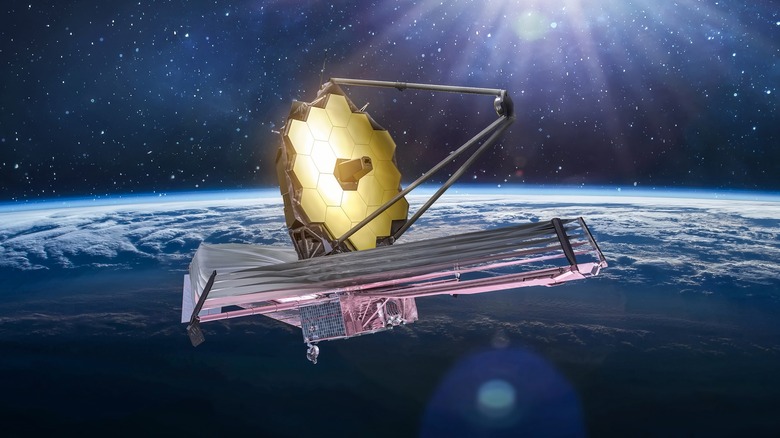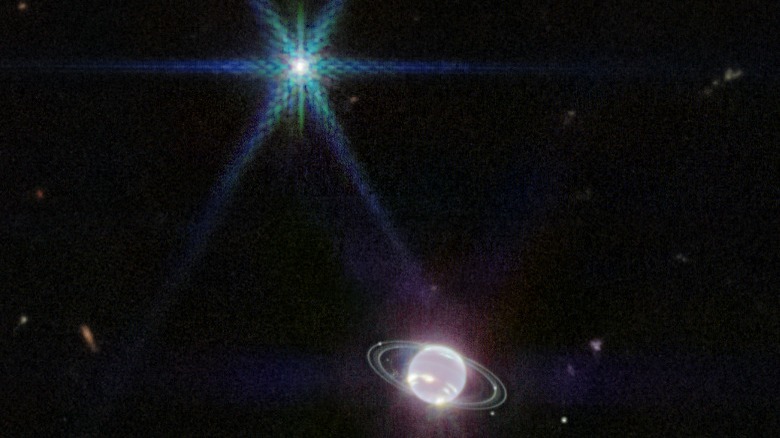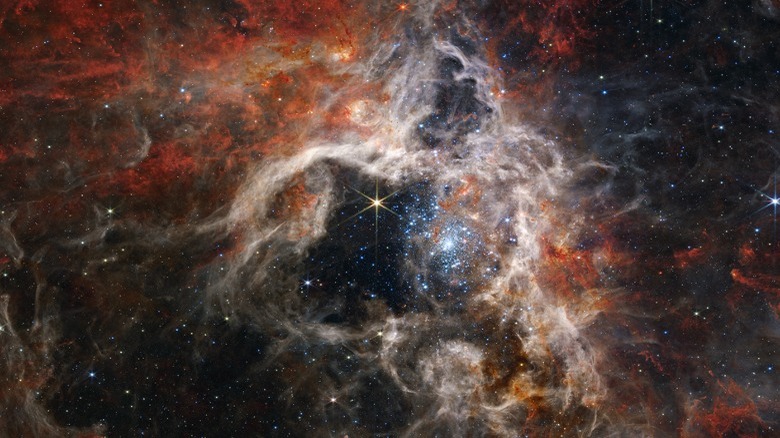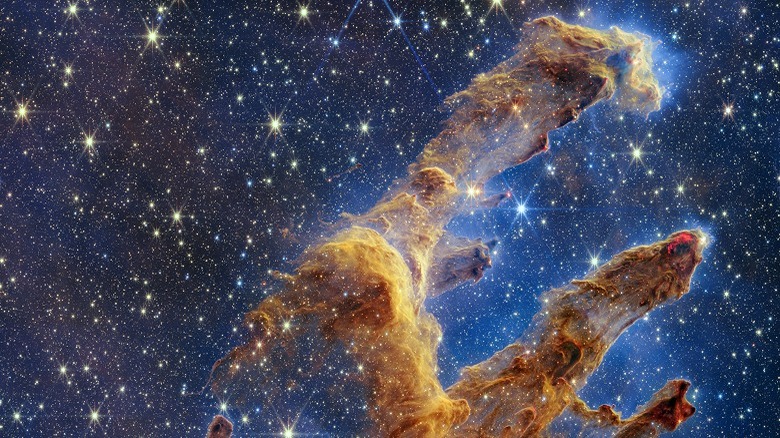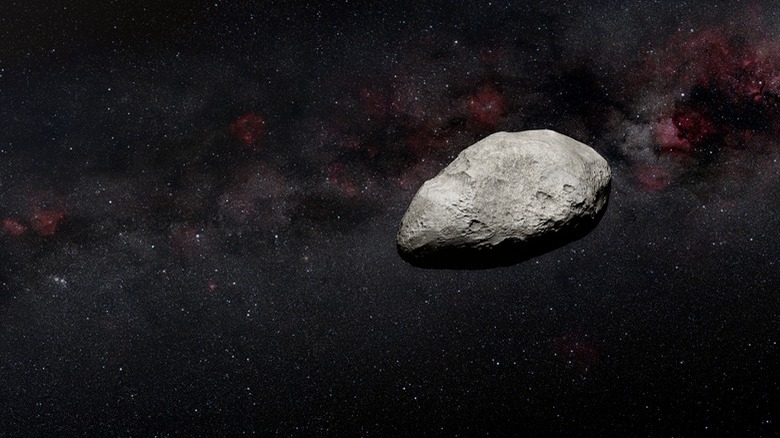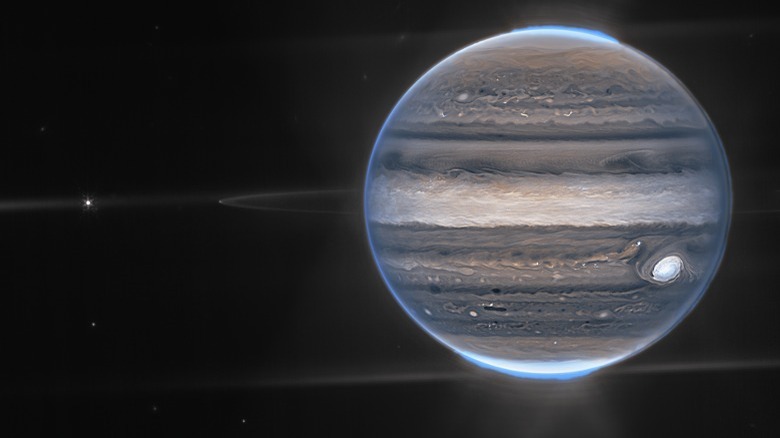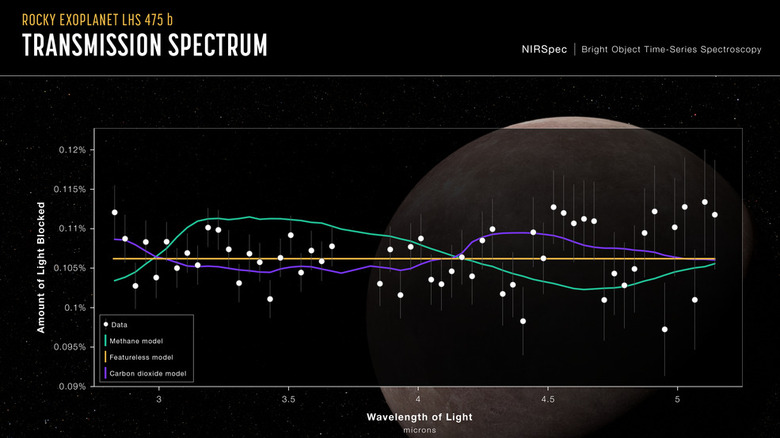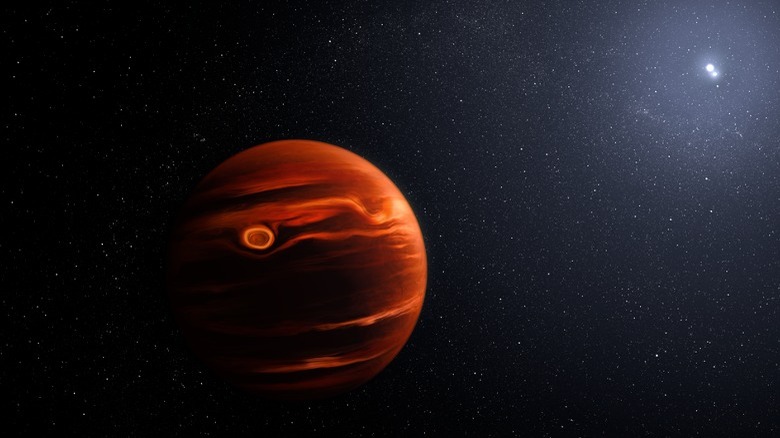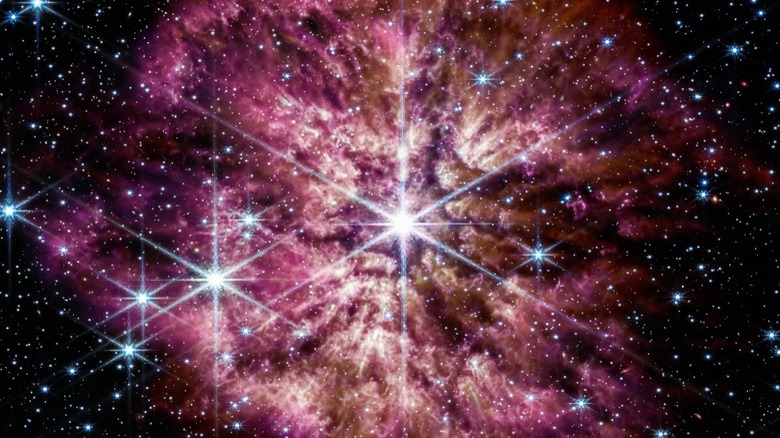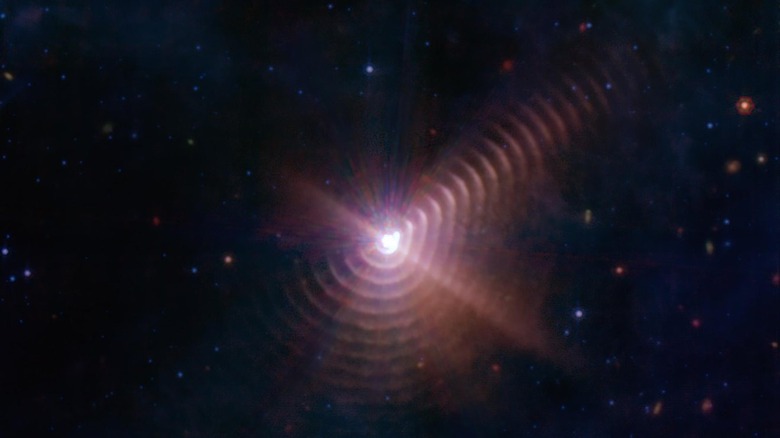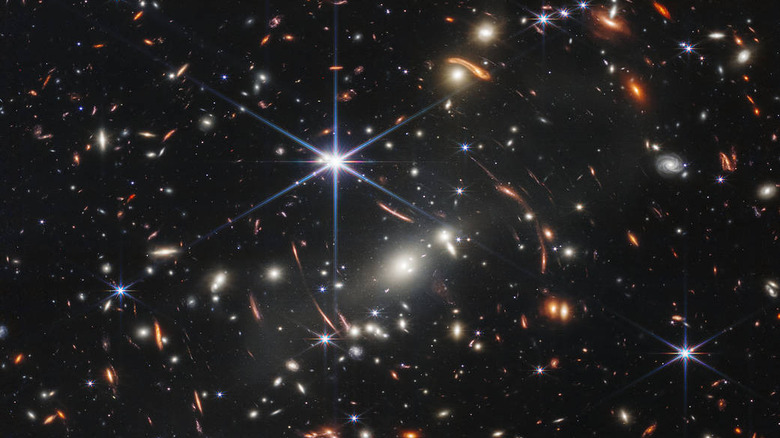10 James Webb Space Telescope Images That Are Changing The Way We See The Universe
By the time Hubble launched in April 1990, astronomers were already thinking about what the next space telescope might look like. While the world marveled at the images Hubble was sending back, plans were underway to build something which could peer back into the earliest days of the universe. Those plans eventually resulted in the James Webb Space Telescope — also known as the JWST.
The JWST is the largest orbiting optical telescope in operation and is designed to maintain piercingly low temperatures of below 40 Kelvin (-233 Celsius, -388 Fahrenheit). The JWST needs to maintain this temperature because it is designed to pick up on infrared light, and anyone who has ever watched "Predator" knows heat generates IR light. If the telescope gets any warmer than 40 Kelvin, its own heat will wash out the faint infrared light from whatever it's observing.
After decades of planning, setbacks, perseverance, and tweaks, the telescope finally launched on Christmas Day 2021. It spent the next few months getting to its permanent home at Earth's L2 Lagrange point and calibrating its instruments. Then, in July 2022, the JWST started sending back images from as close as our own celestial backyard and as distant as 13 billion light years away. Not only are they beautiful, but they're also helping scientists rewrite what we know about the universe and our place in it. Here are 10 images that the JWST has provided us that are changing our understanding of the universe.
Neptune
In September of 2022, NASA released JWST images of the furthest planet in our solar system — apologies to Pluto — Neptune. First discovered in 1846, the distant ice giant lies roughly 30 times farther from the Sun than we are. That makes observing it difficult, but the JWST has a sharp eye.
Using the telescope's Near-Infrared Camera (NIRCam), astronomers imaged the planet and surrounding objects at frequencies between 0.6 and 5 microns. Methane in the atmosphere absorbs red and infrared, giving the planet its blue hue, but because infrared is being absorbed, the planet appears dark in the image. Bright spots and streaks dotting the surface mark where methane clouds float higher in the atmosphere and reflect light back at the telescope before it gets absorbed.
Zooming out, you can see Neptune's faint dust rings. In fact, this is the clearest image of Neptune's rings we've received since Voyager passed the planet back in 1989. You can also pick out seven of Neptune's 14 moons, most of them just visible in the background. The major exception is Triton, visible above and to the left of the planet. It's marked by the JWST's signature diffraction spikes. While those are most commonly seen from stars, Triton reflects 70% of the sunlight that strikes it, causing it to outshine its peers.
Tarantula Nebula
Also arriving in September 2022 were JWST images from a star-forming region in the Large Magellanic Cloud galaxy, roughly 161,000 light years away. There lies the Tarantula Nebula, otherwise known as 30 Doradus, the brightest and the largest star-forming region in the Local Group.
Earlier photographs of the nebula highlighted dusty filaments stretching out from the center like the legs of a gargantuan spider. In the new JWST images, those filaments are largely obscured by the sheer volume of detail. Now, the nebula looks more like a shattered and discarded exoskeleton, so the name still fits. JWST looked at the nebula with its near-infrared NIRCam instrument as well as its mid-infrared MIRI instrument.
In the NIRCam image you can see a cavity carved out by the births of thousands of stars, which you can see clustered together near the center. In the MIRI image shared by NASA, the stars disappear in place of colder gas and dust. The combined images provide scientists with crucial new data to help them understand the interplay between gas, dust, and stars in these stellar nurseries. It might even help us better understand how stars formed during the earliest stages of the universe.
Pillars of Creation
There are few astronomical structures as iconic as the Pillars of Creation. Hubble's famous image of the star-forming nebula is among its most famous, but astronomers couldn't help finding out what they might see with the James Webb Space Telescope.
The pillars themselves are only a small part of the much larger Eagle Nebula, which is roughly 6,500 light-years away from our solar system. These interstellar structures take their name both from their characteristic towers of gas and dust and from the stars which are forming inside of them. Gas and dust come together and stay together, bound by the weak influence of gravity. As an object becomes more massive it exerts more gravitational influence and pulls in even more gas and dust. This continues until the gravitational pressure in the core exceeds the forces keeping individual atoms apart and they begin to fuse. Eventually, a new star is born. Right away, the newborn star begins blasting solar winds in every direction, pushing away the same gas and dust which allowed its formation. The result is an uneven erosion that looks a little like a giant hand reaching for the heavens.
Hubble revisited the Pillars of Creation in 2014 and returned a crisper and more detailed image, but even that pales in comparison to the staggering display captured by the JWST. Stars inside and behind the nebula, previously obscured by the nebula itself, shine through brilliantly.
Accidental asteroid
You know you've got an effective space-based observatory when it accidentally makes discoveries while adjusting its instruments. A European team of astronomers was using the telescope to look at an asteroid in the plane of the asteroid belt, but first they needed to calibrate the instruments. In this case, that involved aiming at their target asteroid, known as 10920 (1998 BC1), and then taking a picture to see if the image was in focus.
Astronomers at first considered the images a failure. The telescope wasn't properly calibrated, and the asteroid was way too bright. However, when evaluating the images, scientists noticed a cosmic stowaway hiding out in the same field of view. Astronomers estimate that the asteroid is between 100 and 200 meters in diameter and is likely a rock no one has ever seen before.
Scientists noted that this is clear evidence that the JWST can and does provide valuable scientific information even when the intended observation might be a failure. Moreover, they suggested that any brief observation of the plane of the asteroid belt will likely result in new asteroids being found. There are so many of them floating around out there that you're basically bound to see one if you point in the right direction.
Jupiter
Images of Jupiter are always beautiful, no matter what you use to take them, and that's especially true in this case. Astronomers produced two separate images of the gas giant using the telescope's NIRCam instrument. In reality, the images are the result of several different exposures combined together in a photo collage. NIRCam used three different filters to look at Jupiter at various wavelengths of light. Information from each filter is then translated into colors we can see, as the infrared light the telescope detects isn't visible to human eyes. The result is a pair of portraits that make Jupiter look even more alien than it did before.
The first image focuses on the planet, drawing out as much detail in the surface features as possible. The second takes a wider view and looks at Jupiter as a system. That image reveals the relatively small and incredibly faint rings surrounding the planet, a smattering of moons, and bright aurora at the poles. Standing in the spotlight, as always, is Jupiter's Great Red Spot, glowing like a specter in the vast cosmic dark.
Gas giants are incredibly common in the universe, making up a sizeable portion of the exoplanets we've discovered. A better understanding of the gas giants in our own backyard could reveal new information about other worlds.
JWST's first exoplanet
We are presently living in the heyday of exoplanet discovery. What started as an exceedingly rare and momentous occasion is now commonplace. To date, more than 5,000 exoplanets have been confirmed by NASA with thousands of additional candidate worlds identified.
With the launch of the JWST, we have a new tool in our arsenal and the telescope has already made its first confirmation. Even more exciting, the JWST is capable of parsing more information than any other telescope, giving it a clearer window into potentially Earth-like worlds. For its first at-bat, the telescope pointed toward a candidate exoplanet previously known as LHS 475 b. The object was first tagged as an object of interest by another orbital observatory, NASA's Transiting Exoplanet Survey Satellite (TESS).
The TESS data suggested something might be there, but we needed to make additional observations to confirm its existence. That's where the JWST came in. The telescope watched two transits, during which the planet crossed between us and its parent star and validated its presence — but it doesn't have to stop there.
The JWST is sensitive enough to not only see the light of distant objects but to tease it apart to see what an object is made of. Elements, like macroscopic objects, have a sort of color, and each element emits signature frequencies when energized. This means the JWST can tell what a planet's surface or atmosphere is made of by the fingerprint hidden in its light.
Exoplanet cloud features
The exoplanet confirmed by the JWST, dubbed VHS 1256 b, orbits a binary star system at a distance that is roughly four times the distance from the Sun to Pluto. As a result, the planet has a relatively familiar 22-hour day but a "year" that lasts 10,000 Earth years. As it's so far away, light from the planet doesn't get mixed up with light from the stars.
The JWST confirmed that VHS 1256 b's atmosphere continually cycles, swapping warmer material nearer the surface for colder material higher up. The resulting difference in temperature is dramatic enough for the telescope to detect. In fact, the exoplanet is the most variable planetary-scale object ever observed.
VHS 1256 b is a brown dwarf, a class of object which exists in the middle ground between a large gas giant and a low-mass star. It's large enough that the force of its own gravity generates intense heat but isn't strong enough to fuse hydrogen. Due to its high mass, temperatures on the planet get up to a blistering 1,500 Fahrenheit despite the incredible distance from a star. Scientists were able to detect a number of materials in the atmosphere including water, carbon monoxide, and methane. They also saw massive silicate clouds (dust and grains of sand) blazing brilliantly.
Seeing a world around another star is one thing, but picking out cloud features on one is a whole other level.
Looming supernova
Shortly after it entered operation in 2022, one of the JWST's earliest observations was of a star currently in the process of blowing up. Wolf-Rayet 124 (WR 124 for short) is about 15,000 light-years away in the constellation of Sagitta and it's burning the house down with itself inside.
Counterintuitively, the more massive a star is, the shorter it sticks around. WR 124 started with roughly 40 times as much mass as our Sun but has lived a considerably shorter life. That's because the more massive a star is, the quicker it burns through its fuel. More gravity means more fusion — giant stars are literally burning the candle at every possible end. Some massive stars enter into what's known as a Wolf-Rayet phase before they shuffle off the celestial coil. During this phase, the surface layers are enriched with heavy elements, which are shed into the surrounding space. As those layers spread out, they cool into shells of dust. That's the mass of material you see surrounding the star in the image.
Once the star sheds enough material it won't have enough mass to hold itself together and will come apart in a violent supernova explosion. This phase of a massive star's life is rare (only some massive stars go through it) and they account for only a small fraction of the star's life. Catching one in progress is the astronomical equivalent of taking a picture of a thunderstorm and capturing a lightning strike.
Cosmic fingerprint
Astronomers have been interested in another Wolf-Rayet star, WR 140, for some time. That's because observations revealed a couple of unusual dust rings surrounding it. WR 140 is about 5,000 light years from our solar system and is actually two stars orbiting one another.
Their orbits are elongated, taking them further apart and then closer together on an eight-year cycle. As the stars spin about their orbits, they eject streams of energized gas called solar wind. When their orbits bring them close together, about the same distance from the Earth to the Sun, their solar winds collide with enough force to transform some of the gas into dust. When the stars separate again, that dust gets blown out in a shell, continually spreading away from the center.
Like the rings of a tree, the rings around WR-140 track the passage of time. The space between each ring represents the eight years between each closest approach. Previous observations with other instruments identified only two rings, but the JWST's sensitive MIRI instrument was able to see at least 17, accounting for more than a century of the star's recent history.
Wolf-Rayet stars are rare — only about 600 have been discovered in our galaxy, and an even smaller fraction produce dust. Of all those, only WR-140 creates rings to paint its history across the sky.
SMACS 0723
The JWST's image of SMACS 0723, a galaxy cluster approximately 4.6 billion light years away, was one of its first and remains one of its best. The image was the telescope's first infrared deep field image and was released in July of 2022 as part of the first batch of five images shortly after the telescope finished setting up shop at the L2 Lagrange point.
The image is startling to look at, both for the sheer number of objects visible and because of its implications for astronomers. The image covers an area of the sky roughly equivalent to what would be covered by a single grain of sand held at arm's length, but it is absolutely jam-packed with galaxies. Over the course of several weeks, the JWST spent 12.5 hours gathering light at different infrared wavelengths.
The galaxy cluster at the center of the image is SMACS, and its light took 4.6 billion light years to reach us — but some of the light in that picture is much older. The combined gravity of the cluster acts like a lens, bending spacetime around it. Astronomers can look through that distortion as if through a cosmic looking glass to see objects much older and farther away. Some of the galaxies in the image formed less than a billion years after the Big Bang, making them some of the earliest complex structures we've ever seen. And there's no telling what the JWST might find tomorrow.
